Laurie Anne Walden, DVM Photo by Madalyn Cox on Unsplash Photo by Madalyn Cox on Unsplash Environmental enrichment means modifying an animal’s living space to encourage physical activity and allow the animal to engage in behaviors that are natural for its species. For indoor pets especially, environmental enrichment improves physical and mental health and can reduce behavior problems. Dogs and cats with mobility problems need environmental modification for accessibility and mental stimulation. Pets have mobility limitations for a variety of reasons:
Household Modifications and Physical Activity Cover hard floors with nonslip mats or rugs. Consider using lots of small washable mats instead of large rugs for easier cleaning if your pet urinates or defecates on the floor (common in animals with medical problems, mobility limitations, or cognitive decline). Be sure to have a nonslip surface in front of your pet’s food and water bowls. Use steps and ramps. Think of all the places your pet likes to be that are not the floor—bed, sofa, cat tree (climbing structure), window seat, and so forth—and make sure your pet can get up and down without jumping. You might need to train your pet to use steps and ramps by leading them with treats. Cats need to scratch for claw health and their mental health (it’s normal species behavior). Reaching and stretching can be difficult for cats with arthritis, so offer your cat horizontal as well as vertical scratching surfaces. Ask your veterinarian about exercise that’s appropriate for your pet. Depending on the medical condition, your pet might benefit from controlled gentle exercise. Some veterinary facilities have physical rehabilitation equipment like underwater treadmills. Toileting Difficulty reaching the toileting area causes anxiety for animals. For cats, put low-sided litter boxes on every floor of the house in quiet, accessible areas. Cats tend to be most comfortable toileting in big open boxes (at least 1.5 times the length of the cat, not including the tail). A large plastic storage bin makes a great litter box; cut an opening on one side so your cat can walk in and out easily. Dogs with new mobility problems or cognitive decline might not give you their usual cues that they need to go out. If your dog or cat starts having toileting accidents indoors, make a veterinary appointment to check for a medical reason. If no medical cause is found, your pet might be having trouble getting outside or to the litter box. Mental Stimulation Engage your pet’s senses: use toys with different odors, textures, and sounds. Puzzle feeders and treat-dispensing toys engage the brain and encourage physical activity. Teach your old dog or cat new tricks. Use positive reinforcement to train new behaviors that don’t require a lot of movement (like touching their nose to your hand). For dogs with mobility problems, walks aren’t really about walking. Just seeing and smelling the outdoors is valuable mental enrichment for dogs. Take your dog out on a harness and forget about actually getting anywhere; be patient and let him sniff and wander at his own pace. If your dog can’t walk easily, carry him or use a wagon. Give your cat a soft seat by a window if possible. Your cat might also enjoy cat-friendly videos. For More Ideas Home modifications. International Cat Care. 2024. Accessed June 18, 2024. https://icatcare.org/app/uploads/2024/03/Changes-to-the-home-environment_ISFM-caregiver-guide_FINAL.pdf Sueda K, Cho J. Environmental enrichment for senior dogs and cats. Clinician’s Brief. December 2017. Accessed June 18, 2024. https://www.cliniciansbrief.com/article/environmental-enrichment-senior-dogs-cats Image source: https://unsplash.com/photos/black-cat-on-white-cat-tree-X7OokuRyvCI Rachel Gutierrez, DVM Cats need access to food, water, shelter, and litter boxes. We can consider these their essential needs to survive; however, they also need means to express typical species behavior like hunting, viewing, climbing, scratching, and playing. Enrichment enhances our cat’s environment by giving them chances to express these behaviors. This can improve their mental and physical well-being and even reduce unwanted behaviors. Any changes in routine can be stressful for cats and any new activity or changes in environment are recommended to be done slow and steady. Different Types of Enrichment Food puzzles/foraging toys: Food puzzles are a great way to increase your cat's activity and mental stimulation. There are a variety of commercially made food puzzles like Doc and Phoebe’s mice, sniffle mats, Trixie puzzle feeders, etc. Some of these are stationary and others cats have to move around to get food out of them. You can also make your own using cardboard boxes, towels, toilet paper roll, etc. When introducing your cat to any food puzzle, recommend starting easy then building up to more challenging puzzles. Toys: Cats have a natural instinct to hunt and we can use this instinct to get them to play. Cats typically like mice, bugs, and birds as prey when they live outdoors. With this in mind, using toys that mimic the feel, sound, or movement of mice, bugs, or birds can entice cats to play more. Some examples are wand toys with feathers or faux fur OR cat dancer toys (mimic a bug). It is best to rotate toys so they do not lose interest (ideally every few days). Clicker training: Cats can be trained to do a variety of tricks (sit, high-five, lay down, etc) or go through an obstacle course. Clicker training can even be used to help you medicate your cat (with appropriate training). Recommend getting a clicker with a ball at the end (this can be purchased online). Sensory enrichment: Videos of mice, birds, or fish can be stimulating for cats (YouTube videos). Or set up a bird feeder outside near their favorite window with a window perch. For their sense of smell and need to chew, catnip or silvervine or cat grass can be stimulating for them. Outdoor walks or screened-in porches are great sources of enrichment for cats as well (please ensure this is under supervision). Environmental enrichment (cat trees, scratchers, and more): One of the cat’s essential needs is shelter, which includes a safe place to sleep and rest; however, this also includes a place to have time alone or get away from people or other animals. This is where cat trees or other vertical spaces can be very useful. It also creates areas where you can have playtime or feed them or use it as part of an obstacle course. Another important behavior/need cats have is scratching. This is important for their nail health. Many cats have preferences of the material and vertical versus horizontal. I recommend trying out the different options. There are a variety of other cat furniture ideas you can use for enrichment, such as shelves, tunnels, window perches, etc. Consider changing the positions or locations of any of these to renew their interest. Check out these resources for more ideas regarding feline enrichment:
Laurie Anne Walden, DVM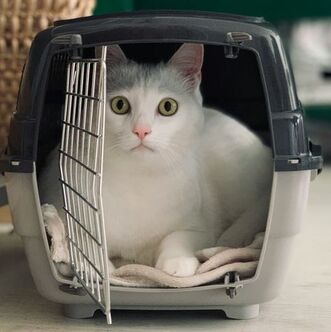 Photo by Anatolii Kozhukhar on Unsplash Photo by Anatolii Kozhukhar on Unsplash Many dogs and cats experience fear, anxiety, and stress at the veterinary clinic. Their anxiety often begins before they even arrive at the clinic, especially if they associate pet carriers and car rides with the clinic. Previsit antianxiety medications for pets can make clinic visits easier and safer for these pets, their owners, and clinic staff. These are some of the benefits of previsit medications for anxious pets:
Previsit medications have benefits for pet owners and clinic staff members too. Being the caretaker of an anxious and fearful pet isn’t easy, so previsit medications for pets can reduce everyone’s stress levels. For clinic staff members, managing patients’ clinic anxiety reduces the risk of injury and decreases workplace stress (we love animals too and don’t want to cause them distress). How to Know if Your Pet Needs Previsit Medications Previsit medications aren’t just for aggressive animals. Pets with more subtle signs of stress are scared too, and they deserve help for their anxiety just as much as animals that can’t be handled without full sedation. If your pet shows obvious signs of fear at the clinic, you probably already know that your pet would benefit from previsit medications. But maybe your pet’s signs are not as noticeable and you’re a little surprised when your veterinarian recommends medications. Dogs and cats show anxiety and fear with a range of behaviors and body language cues. Anxious and fearful dogs and cats tend to start with subtle behaviors like lip licking or freezing. If the scary thing doesn’t go away—or tries to draw a blood sample—the behavior can escalate to aggression. Dogs and cats that are anxious at the veterinary clinic can show these signs:
How to Use Previsit Medications Previsit medications work best if they’re used along with training and positive reinforcement. For example, a cat can make positive associations with the cat carrier if the carrier is left out all the time as part of the normal household furniture, sometimes with yummy treats inside, instead of appearing only when the cat is going to the clinic. Veterinarians choose previsit medications according to the needs and medical condition of the individual patient. Some of the drugs commonly prescribed for situational (short-term) anxiety are gabapentin, trazodone, and clonidine. Motion sickness contributes to anxiety, so pets might also receive antinausea medication. Some of these medications can cause sedation, but the main goal is anxiety reduction, not sedation. Previsit medications are timed to have maximum effect at the time of the clinic visit. They need to take effect before the pet experiences any stress. Most of these medications are given at least 1 to 2 hours before the clinic visit; sometimes a loading dose is also given the night before. They typically last for up to 8 hours, although the duration can vary. Because individual animals respond differently to these medications, giving a trial dose can be very helpful. If you use a trial dose, tell your veterinarian how long it took for the medication to take effect, how the medication affected your pet’s behavior, whether your pet had adverse effects like vomiting or excessive sedation, and how long the medication’s effects lasted. For some dogs and cats, previsit medications aren’t enough to overcome their fear. These pets might also need a sedative injection at the clinic. For these pets, previsit medications given at home make the sedative injection easier for the pet (and staff) and can also reduce the dose of injectable drug. Image source: https://unsplash.com/photos/a-white-cat-sitting-inside-of-a-cage-B-_SyRxv2So Laurie Anne Walden, DVM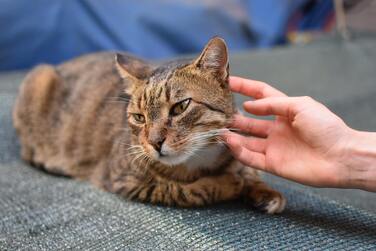 Photo by Ilze on Unsplash Photo by Ilze on Unsplash Aggression related to being petted is very common in cats. Cats with this type of aggression suddenly scratch, growl, or bite while they’re being petted. The most likely explanations for petting-related aggression are that the cat is overstimulated, has a low tolerance for being touched, or is trying to exert some control over the interaction. It’s also possible that the cat has a medical problem (for example, pain caused by arthritis or dental disease). Any type of aggression, especially if it’s a new behavior, warrants an examination by a veterinarian. The people most at risk of injury are children and others who don’t know the signs that a cat is uncomfortable with an interaction. Tolerance to petting varies from cat to cat, and the same cat’s tolerance can change according to the circumstances. To help people understand the best way to interact with cats, a team of researchers in the United Kingdom developed a set of guidelines that they describe with the acronym CAT (for choice, attention, and touch).[1] The team found that cats showed less aggression when people followed the CAT guidelines during interactions. The gist of the CAT guidelines is that we should handle cats the way they want to be handled and leave them alone when they want to be left alone. Makes sense, right? However, in another study, the same team found that some people who had lots of cat-owning experience and rated their own cat knowledge as high interacted in ways the cats did not want.[2] The following is a summary of the CAT guidelines, or how to pet a cat. C: Give the cat choice and control.
A: Pay attention to the cat’s body language. These are signs that a cat might not want to be petted any longer:
T: Touch the cat only where the cat wants to be touched.
To read more about cat-friendly petting and how humans interact with cats, check out these 2 articles:
References 1. Haywood C, Ripari L, Puzzo J, Foreman-Worsley R, Finka LR. Providing humans with practical, best practice handling guidelines during human-cat interactions increases cats' affiliative behaviour and reduces aggression and signs of conflict. Front Vet Sci. 2021;8:714143. doi:10.3389/fvets.2021.714143 2. Finka LR, Ripari L, Quinlan L, et al. Investigation of humans individual differences as predictors of their animal interaction styles, focused on the domestic cat. Sci Rep. 2022;12(1):12128. doi:10.1038/s41598-022-15194-7 Photo by Ilze on Unsplash Laurie Anne Walden, DVM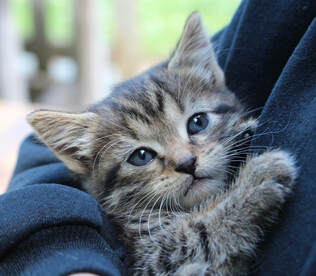 Photo by Haley Owens Photo by Haley Owens Socializing young kittens and puppies means giving them positive experiences with things they’ll encounter throughout their lives. Building positive associations early in life helps animals feel comfortable with new people and new situations. Animals that are well socialized when they’re young are less likely to develop fear-based behavior problems (like aggression) that could put them at risk of being sent to a shelter or euthanized later on. Sensitive Period for Socialization For kittens, the window of opportunity for socialization is very early: from 3 weeks to about 7 to 9 weeks of age.[1,2] The sensitive period is the time when a young kitten’s brain is most receptive to socialization. During these early weeks, a kitten is exploring and learning, developing neurological pathways that will help the kitten learn in the future. After the sensitive period, brain development shifts; kittens don’t make positive associations as quickly or easily and they’re more likely to be afraid of new things. This is why it’s so difficult, if not impossible, to convert a semi-feral adult cat into a cat that can be happy living as a house pet. You will have noticed that the sensitive socialization period for kittens is nearly closed by the time they’re typically adopted or purchased. Socialization needs to start with the person caring for the mother cat and newborns. When you adopt or buy a kitten, continue providing socialization (at the kitten’s comfort level and pace) to reinforce what the kitten has already learned. The socialization process should always be positive. Don’t force kittens to interact with strangers or other animals if they’re shy, and don’t push them to be near things that scare them. Let them choose whether to interact. Give them room to walk away and let them hide if they want to. Use positive reinforcement (food or play) to encourage them to interact and build their confidence. The following suggestions are adapted from the American Veterinary Medical Association.[1] For more tips, check out the First Year of Life page on the Cat Friendly Homes website: https://catfriendly.com/life-stages/first-year-life/ Socializing Kittens Before Weaning
Socializing Kittens 8 to 12 Weeks Old
Older Kittens and Newly Adopted Adult Cats
References 1. Welfare implications of socialization of puppies and kittens. American Veterinary Medical Association. June 9, 2015. Accessed July 8, 2022. https://www.avma.org/resources-tools/literature-reviews/welfare-implications-socialization-puppies-and-kittens 2. Todd Z. The sensitive period for socialization in puppies and kittens. Companion Animal Psychology. July 26, 2017. Accessed July 8, 2022. https://www.companionanimalpsychology.com/2017/07/the-sensitive-period-for-socialization.html Photo by Haley Owens on Unsplash Laurie Anne Walden, DVM Photo by Tyler Farmer Photo by Tyler Farmer Holiday celebrations can be stressful for pets. Visitors, changes in routine, changes in food, unfamiliar scents and objects in the home, traveling, and noise can all cause anxiety for animals. Animals are more likely to bite when they’re scared or anxious, so minimizing sources of stress for your pets will help keep the holidays happy for everyone. Limit Stressful Situations To identify sources of stress for your pets, think like an animal. Animals feel safest when their routines and environment are predictable. Keep meal times, nap times, and exercise and play schedules about the same as usual. You might want to sleep late on a holiday (OK, the day after a holiday), but if your pets are used to a very consistent morning routine, this change could contribute to stress. It’s normal and very human to want to include pets in our celebrations, but be careful not to think of your animals as little people in fur (or scale or feather) coats. They won’t feel left out if they’re not invited to a party. Most animals would rather be in a nice quiet room than in the middle of holiday hubbub. Think about your pets’ usual behavior around strangers and noise, and let them stay wherever they are most comfortable and safe. Be aware of foods that aren’t safe for animals, especially if you have visitors who don’t know what your pets should and shouldn’t eat. Chocolate, xylitol sweetener, grapes, raisins, onion, garlic, and raw yeast dough are some of the foods that can be dangerous for animals. Limit or avoid table food for your pets; fatty or rich food can cause digestive upset. A holiday trip to the emergency veterinary clinic is not on anyone’s wish list. Contact your veterinarian in advance if your pet is afraid of fireworks or has travel anxiety. Your veterinarian might recommend prescription or nonprescription antianxiety medication, depending on the symptoms. Plan ahead for this. Your pet might need a veterinary examination before medication can be prescribed. Watch for Signs of Stress The early signs of fear and anxiety can be subtle. Owners sometimes don’t realize their pets are in distress until the behavior escalates to aggression (an attempt to remove a perceived threat). Watch for any changes from the usual behavior. Some animals withdraw and hide in response to stress; others become hyperactive or clingy. Signs of Anxiety in Dogs
Signs of Anxiety in Cats
Photo by Tyler Farmer on Unsplash Laurie Anne Walden, DVM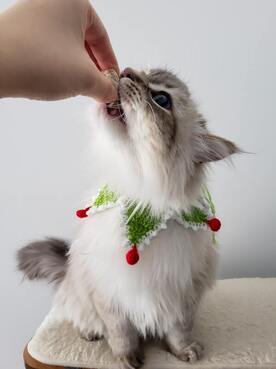 Photo by Long Ma Photo by Long Ma The way we feed cats—not just the type of diet we choose—can affect their physical and mental health. Animals are happiest and healthiest when they’re able to do all of the things that are normal for their species. For cats, normal feeding behavior is related to their nature as hunters. Almost all cat species are solitary hunters, unlike wolves and other canines that hunt in packs. (Lions are the exception.) Domestic cats have not evolved far from their wild relatives in this respect. This means that pet cats usually like to eat several small meals a day alone, according to the American Association of Feline Practitioners (AAFP). The following suggestions are from the 2018 AAFP consensus statement on feline feeding programs.[1] Potential Health Problems Related to Feeding Methods Some common feeding methods can cause physical and emotional problems for pet cats, says the AAFP. Feeding 1 or 2 large meals a day in a single location contributes to inactivity and weight gain, increasing the risk for medical problems like diabetes. Eliminating the need to hunt reduces a cat’s activity level and mental stimulation. And feeding cats in a group might lead to food-related conflict and stress, which in cats is linked to bladder and behavior problems. Suggestions for Feeding Cats
Suggestions for Multiple Cats
References 1. Sadek T, Hamper B, Horwitz D, Rodan I, Rowe E, Sundahl E. Feline feeding programs: addressing behavioral needs to improve feline health and wellbeing. J Feline Med Surg. 2018;20(11):1049-1055. doi:10.1177/1098612X18791877 2. Delgado MM, Han BSG, Bain MJ. Domestic cats (Felis catus) prefer freely available food over food that requires effort. Anim Cogn. Published online July 26, 2021. doi:10.1007/s10071-021-01530-3 Photo by Long Ma on Unsplash  Photo by Annie Spratt Photo by Annie Spratt Any dog might need to wear a muzzle at some point. Muzzle training makes wearing a muzzle stress-free and even fun for the dog. Resources for training a dog to love a muzzle are linked at the end of this article. Why Dogs Wear Muzzles Muzzles can be incredibly useful. Wearing a muzzle doesn’t necessarily mean that a dog is aggressive. A muzzle is just another tool to help keep dogs and people safe. These are some of the many reasons a dog might use a muzzle:
Choosing a Muzzle The type of muzzle to look for is a basket muzzle. Correctly fitted basket muzzles don’t hold a dog’s mouth shut, so a dog wearing a basket muzzle can pant, drink water, and take treats. Don’t buy a cloth muzzle like the ones sometimes used for dog grooming and veterinary procedures. Cloth muzzles keep the dog’s mouth closed, so these muzzles are not safe for dogs to wear for more than a few minutes and can also be stressful for dogs. Basket muzzles come in various styles, materials, and colors. Some are made of flexible rubber; muzzles made of wire offer more bite protection. Muzzles for specific breeds (like greyhounds) and custom-made muzzles for dogs with hard-to-fit faces are also available. The fit of the muzzle is crucial, so you’ll need to measure your dog’s face according to the manufacturer’s instructions. (Estimate the measurement if your dog might bite when his face is touched.) A basket muzzle should be long enough to avoid rubbing the tip of the nose but not so long that it hits the dog’s eyes, and it should be deep enough to let the dog open his mouth wide to pant. A basket muzzle deep enough to allow for full panting will probably look huge when the dog’s mouth is closed, but this is the correct fit. The muzzle should have lots of openings for air flow. Some basket muzzles have large holes for treats; others have smaller gaps in front of the nose to keep dogs from eating things they shouldn’t. Muzzle Training Basics Dogs accept muzzles most readily if the training involves yummy treats and is done gradually over weeks.[1] Dogs who are already afraid of muzzles need extra training steps and more time; don’t hesitate to seek help from a positive-reinforcement trainer. Watch your dog’s body language throughout training to be sure she’s happy and relaxed. If at any point your dog avoids the muzzle, you’re moving too fast. Back up a couple of steps and proceed more slowly.
Resources
Reference 1. Arhant C, Schmied-Wagner C, Aigner U, Affenzeller N. Owner reports on use of muzzles and their effects on dogs; an online survey. J Vet Behav. 2021;41:73-81. doi:10.1016/j.jveb.2020.07.006 Photo by Annie Spratt on Unsplash Laurie Anne Walden, DVM 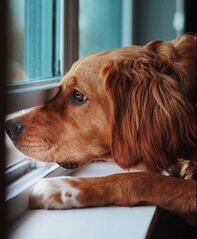 Photo by Mark Zamora Photo by Mark Zamora Separation-related behavior problems are fairly common in dogs and also affect cats. Pets with separation-related distress aren’t acting out of spite or mischief when they shred the sofa cushions or urinate on the carpet. These animals are anxious and afraid, and they need help. Separation anxiety is a catchall term that describes stress-related behaviors that happen when an animal is separated from its attachment person.[1] It causes significant distress to the animal and can lead to relinquishment or euthanasia. Animals with separation anxiety sometimes have other anxiety disorders, like noise phobia. Like other types of anxiety, separation anxiety tends to get worse if it’s not treated. Signs Animals with separation anxiety show distress behaviors only when they’re separated from their people, not at any other time—unless, of course, they also have another source of anxiety. Some signs of emotional distress are obvious:
Other signs are more subtle and may go unnoticed if no one is nearby to see or hear the animal:
Animals with subtle signs of anxiety are in just as much distress as the ones who destroy the house. Unfortunately, these animals might be less likely to get treatment because their signs are harder to spot. In a survey of cat owners, the most common separation-related behaviors in cats were destruction, vocalization, inappropriate urination, depression, aggression, and agitation.[1] Diagnosis Many disorders cause the same signs as separation anxiety. Pets with possible separation anxiety should first see a veterinarian to rule out medical conditions like urinary tract infection, diabetes, and neurological disorders. Because of the complexity of anxiety disorders, pets who show distress behaviors often need a full veterinary appointment dedicated to behavior evaluation, not just a quick discussion during a routine wellness visit. A detailed behavior history from the pet’s owner is crucial. The best way to tell whether problem behaviors are caused by separation is by video recording the pet when the owner isn’t home.[4] Video doesn’t require a home surveillance system; a cell phone can be set up to point at the pet while the owner leaves the house for a few minutes. Separation-related behaviors usually start soon after the owner leaves or even while the owner is getting ready to leave. Video can help pin down the cause of the anxiety (for example, maybe the dog doesn’t rip up the pillows until the mail carrier arrives). Because video is the only way to detect subtle signs of distress, it makes sense for all pet owners to record their animals at some point to be sure all is well. Treatment Managing anxiety in animals usually requires a combination of behavior modification and antianxiety medication. The goal of behavior modification is to teach animals how to relax and calm themselves. Antianxiety medication reduces reactivity so that animals are capable of learning new behaviors, which they can’t do while they’re distressed. Animals with separation anxiety might need more than 1 type of medication: a long-term drug taken daily and a short-acting drug to use in stressful situations or while waiting for the long-term drug to take effect. Antianxiety medications must be prescribed by a veterinarian. Various nonprescription remedies, such as pheromones and nutritional supplements, are also available. Most of these alternative treatments are more expensive than prescription medications and have less evidence to show that they’re effective.[5] Treatment of separation anxiety takes time—think months, not days. The most important early goals are to keep the pet safe and minimize sources of anxiety. These are some steps to take right away while waiting for treatment to take effect:
References 1. de Souza Machado D, Oliveira PMB, Machado JC, Ceballos MC, Sant’Anna AC. Identification of separation-related problems in domestic cats: a questionnaire survey. PLoS One. 2020;15(4):e0230999. doi:10.1371/journal.pone.0230999 2. Overall KL. Advances in treating dogs who cannot be left alone. VMX 2020 Proceedings: Small Animal & Exotics: Book 1. North American Veterinary Community; 2020:120-123. 3. Sherman BL. Canine separation anxiety: a common behavior problem and welfare concern. 2019 Fetch DVM360 Conference Proceedings. MultiMedia Animal Care LLC; 2019:37-39. 4. Tynes VV. Separation anxiety and the “pandemic puppy”: what lies ahead after lockdown. American Animal Hospital Association. Accessed June 22, 2021. https://www.aaha.org/publications/newstat/articles/2021-06/separation-anxiety-and-the-pandemic-puppy-what-lies-ahead-after-lockdown/ 5. Brooks W, Calder C, Bergman L. Separation anxiety: the fear of being alone. Veterinary Partner. June 4, 2020. Updated July 14, 2020. Accessed June 22, 2021. https://veterinarypartner.vin.com/doc/?id=9673053&pid=19239 Photo by Mark Zamora on Unsplash Laurie Anne Walden, DVM  Even friendly dogs can bite if provoked. Even friendly dogs can bite if provoked. Dog bites are physically and emotionally traumatic and can also have serious consequences for the dog. National Dog Bite Prevention Week, the second full week of April, is a good time to learn more about dog bites. Why do dogs bite? Dogs bite as an instinctive response to provocation. Even friendly, tolerant dogs can bite under the wrong circumstances. A dog might bite a person in situations like these:
Which dog breeds are likely to bite? Trick question! Any dog can bite if provoked. Assuming that a dog is aggressive because of its breed is unfair to responsible dog owners and (in the case of breed bans) potentially unsafe for the dog. It’s even more dangerous to assume that a dog won’t bite because it looks like a breed people think of as “friendly.” It’s almost impossible to tell the breed heritage of a mixed-breed dog just by appearance anyway. A dog’s body language and facial expressions are better indicators of bite risk than its (apparent) breed is. These cues can be subtle, but learning to tell if dogs are feeling anxious, afraid, or aggressive can help keep you safe. Who’s at risk of being bitten? At least half of the people bitten by dogs in the United States each year are children, according to the American Veterinary Medical Association. Older adults are also at higher risk. Most people with dog bites are bitten by their own dog or another dog they’re familiar with. How can I keep myself and my kids from being bitten? These measures can reduce the risk:
What can dog owners do? Socialize puppies and newly adopted dogs so they’ll be comfortable with different people and new situations. Dogs who are well socialized are less likely to feel nervous or threatened when they encounter new people and unfamiliar environments. Obedience training using positive reinforcement also builds trust between dogs and their owners. Be sure your dog’s rabies vaccination is up to date. Monitor your dog’s health; pain and illness reduce a dog’s tolerance for being touched and handled. Don’t let your dog run free outdoors, and follow your local leash laws. If your dog is nervous around unfamiliar people, be sure he has a place to get away from visitors to your home. More information
Photo by Ralu Gal |
AuthorLaurie Anne Walden, DVM Categories
All
Archives
June 2024
The contents of this blog are for information only and should not substitute for advice from a veterinarian who has examined the animal. All blog content is copyrighted by Mallard Creek Animal Hospital and may not be copied, reproduced, transmitted, or distributed without permission.
|
- Home
- About
- Our Services
- Our Team
-
Client Education Center
- AKC: Spaying and Neutering your Puppy
- Animal Poison Control
- ASPCA Poisonous Plants
- AVMA: Spaying and Neutering your pet
- Biting Puppies
- Boarding Your Dog
- Caring for the Senior Cat
- Cats and Claws
- FDA warning - Bone treats
- Force Free Alliance of Charlotte Trainers
- Getting your Cat to the Vet - AAFP
- Holiday Hazards
- How To Feed Cats for Good Health
- How to Get the Most Out of your Annual Exam
- Indoor Cat Initiative - OSU
- Introducing Your Dog to Your Baby
- Moving Your Cat to a New Home
- Muzzle Training
- Osteoarthritis Checklist for Cats
- What To Do When You Find a Stray
- Our Online Store
- Dr. Walden's Blog
- Client Center
- Contact
- Cat Enrichment Month 2024
|
Office Hours
Monday through Friday 7:30 am to 6:00 pm
|
Mallard Creek Animal Hospital
2110 Ben Craig Dr. Suite 100
|
Site powered by Weebly. Managed by IDEXX Laboratories

 RSS Feed
RSS Feed